This is the article that nearly got away. Written for and submitted to Coarse Fisherman magazine, it would have been in the next issue had the magazine not ceased trading. Some things are not meant to be, and although I’m sure it would have been snapped up by another publication I’ve decided to let it wander free in cyberspace. See what you think…
Bob Roberts
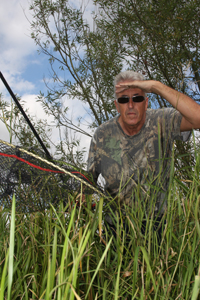 It was probably during the editing process of the third Barbel Days And Ways DVD that Stu Walker and I became acutely aware of the fact that you cannot really make sweeping generalisations about all barbel.
It was probably during the editing process of the third Barbel Days And Ways DVD that Stu Walker and I became acutely aware of the fact that you cannot really make sweeping generalisations about all barbel.
Barbel in different rivers can and do behave differently due to the differing river characteristics and presumably due to genetic variations. This much is pretty obvious to any experienced and well-travelled angler but what we recognised beyond any doubt was that certain individual barbel within a given shoal would act differently to the others. Some would be more confident to the point of being reckless whilst others would show extreme caution and it is certainly not down to size or age.
The concept that a bigger barbel is harder to catch because it is older and wiser is flawed to the point of being laughable. Big barbel are not more difficult to catch than medium sized barbel, there are simply less of them. They undoubtedly eat less than small barbel, too, and before you go thinking I’ve lost the plot, just take any other living creature and consider how they feed over the course of their lives.
Babies have to be fed every two hours or so. A shrew has to eat at some ridiculous frequency like every twenty minutes or it starves to death. Size doesn’t come into it but metabolism and activity does. Smaller fish dash around and expend energy all the time plus they need to feed consistently to promote growth. Older fish that have realistically reached their maximum skeletal size tend to eat only what they need to be satisfied and they find quieter water for much of the time.
Human children are hungry all the time and crave certain tastes, mostly sweet or dosed with sugar like fizzy drinks, sweets and fast foods, whilst an adult might eat less regularly and more sensibly. Kids gobble down their food while adults might spend two hours over a leisurely meal. Kids grab food while they’re doing other things and eat on the run whereas an adult is more likely to stick to meal times and eat at a table.
 I know it’s wrong to try and humanise fish but in terms of basic principles we can surely all recognise this pattern and we appreciate that feeding spots can be quite localised as well as the feeding times where big fish are concerned, hence the history of certain fish being caught regularly from the same swim and at fairly specific times. Unless you can accept this you might find fishing for big barbel a pretty tall order. Indeed you will probably only catch them through luck and good fortune. Having the latest rig and fashionable bait doesn’t really come into it.
I know it’s wrong to try and humanise fish but in terms of basic principles we can surely all recognise this pattern and we appreciate that feeding spots can be quite localised as well as the feeding times where big fish are concerned, hence the history of certain fish being caught regularly from the same swim and at fairly specific times. Unless you can accept this you might find fishing for big barbel a pretty tall order. Indeed you will probably only catch them through luck and good fortune. Having the latest rig and fashionable bait doesn’t really come into it.
In a nutshell, the key to catching a big barbel is being in the right place at the right time. However, that alone is not enough unless you are either very fortunate or some kind of time bandit who casts out once and waits for however long is necessary until ‘Gertie the Bertie’ simply happens along and sets your bite alarm wailing.
It’s not for me to say it’s wrong to do that as you must do whatever floats your boat, but to me that simply is not fishing. You might just as well set a bungee line, go home, drink a few beers down the pub, get a good night’s sleep, eat a hearty breakfast and then go back, drag your catch up the bank for a few photos and then brag to anyone who’ll listen that you are a brilliantly talented angler…
I’m sure you can see the parallels, too.
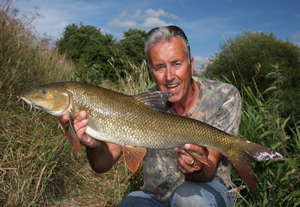 I’ve spent quite a lot of time this season fishing for what many would regard as ‘small’ barbel. The river I’m fishing is quite tiny, being less than 10 yards across in many places and it is mostly shallow, clear and very weedy. The barbel population is nowhere near as great as some would have you believe and repeat captures are the norm. Folk who tell me they’ve caught 50 barbel in a season might only have caught a dozen because they stick to the same old reliable swims every time and whether they care to admit it or not, they’re catching the same fish repeatedly.
I’ve spent quite a lot of time this season fishing for what many would regard as ‘small’ barbel. The river I’m fishing is quite tiny, being less than 10 yards across in many places and it is mostly shallow, clear and very weedy. The barbel population is nowhere near as great as some would have you believe and repeat captures are the norm. Folk who tell me they’ve caught 50 barbel in a season might only have caught a dozen because they stick to the same old reliable swims every time and whether they care to admit it or not, they’re catching the same fish repeatedly.
What many don’t realise is that this happens on big rivers like the Trent, too. It’s fun to catch 20 barbel from a swim but when you go back there for another session do you actually believe another shoal has moved in and replaced the one you hammered last time?
The majority of barbel in my little river probably average between three and 6lb. A weighed 8lb fish from there is a rare beast indeed and a double is worthy of a celebration, certainly from the stretch I’m targeting. And this is where we come back to the size thing again. I have caught a couple of doubles but I’d guess they were more than likely approaching their peak weight genetically.
A ten pounder from this river is every inch as long as a fourteen from many other rivers but these are long, sleek, wild fish, having as much in common with an Ouse gut-bucket as a truly wild carp has to a boilie-fed mirror. But it is clear to see on this river how differently a four pound fish behaves to an eight pounder.
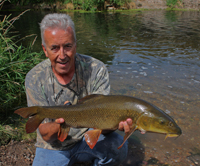 In summer it is not unusual to find one or two of the bigger fish, and there really aren’t that many of them, in company with several smaller specimens and I’m beginning to question my own sanity because I’m starting to think the fish communicate fear with the smaller fish learning from the bigger ones.
In summer it is not unusual to find one or two of the bigger fish, and there really aren’t that many of them, in company with several smaller specimens and I’m beginning to question my own sanity because I’m starting to think the fish communicate fear with the smaller fish learning from the bigger ones.
Let me explain. One of my favourite swims gives me a rare opportunity to climb into the lower branches of a tree from where I can look down on the fish and observe their behaviour clearly. These fish have no fear whatsoever of a bait dropper. Indeed they will rush out to meet it! I’ve seen them sit immediately downstream of the dropper waiting for it to be pulled out of the swim so they can move onto the feed.
Catching the first fish is relatively easy enough but the number of times I’ve seen that fish return to the swim and then dash about madly, flashing violently as if in a warning to the others has made me think seriously about barbel retention. The flashing is similar to that of a feeding display but much faster with the fish darting around at speed along the edge of an area of cover. Whatever the reason it rapidly puts the other fish on edge and from then on, every tiny mistake you make is magnified to the point where the swim is vacated completely.
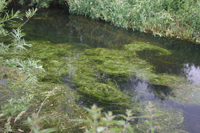 During the early weeks of the season you can swing out a rig with no fear. By August the sound of even the smallest lead hitting the water is enough to send fish scattering for cover. Drifting weed is a problem in high summer and it is nearly impossible to keep a rig in position for more than five minutes, even if you back lead, and that means having to recast regularly. Again this results in the fish becoming more and more cautious.
During the early weeks of the season you can swing out a rig with no fear. By August the sound of even the smallest lead hitting the water is enough to send fish scattering for cover. Drifting weed is a problem in high summer and it is nearly impossible to keep a rig in position for more than five minutes, even if you back lead, and that means having to recast regularly. Again this results in the fish becoming more and more cautious.
Once the fish become cautious you may as well move on to a new swim with the hope of returning later as the situation simply deteriorates to the point where you are wasting good fishing time. The thing is this only happens in swims that have received a degree of pressure. It is still possible to find swims that everyone else has overlooked, tucked away in the most unlikely places, and suddenly it’s possible to catch with ease. Indeed you can take a couple or even three fish from a swim if you’re cautious, but take care to cover your tracks well or your secret will be discovered, fished by others and the fish will wise up.
 Which brings me to another point. The fish here do travel around. Certain identifiable fish have been caught from swims well over a mile apart yet these same individual fish will behave completely differently in virgin swims and pressured swims. The behaviours they display when they feel secure are vastly different to that when they are in well-fished areas. Perhaps they like the surrounding environment enough to overcome the fear of the angler but their sense of caution when feeding is significantly heightened.
Which brings me to another point. The fish here do travel around. Certain identifiable fish have been caught from swims well over a mile apart yet these same individual fish will behave completely differently in virgin swims and pressured swims. The behaviours they display when they feel secure are vastly different to that when they are in well-fished areas. Perhaps they like the surrounding environment enough to overcome the fear of the angler but their sense of caution when feeding is significantly heightened.
I have taken fish from these swims on free-lined baits, although it has to be said you’re lucky to do so because every moving morsel of food gets chased by a chub or three and because your swim is only ten yards wide each cast will last a matter of a few seconds and you simply can’t keep plonking out baits willy-nilly as even the chub start to get wary.
If you swing out a bare lead and follow it down to the river bed with the rod tip on a tight line you will feel a pronounced ‘donk’ when it lands on the gravel. That sound is transmitted to every single fish in the vicinity. The ‘plop’ of a lead hitting the surface is equally distinctive but the two combined are guaranteed to spook practically every fish I have been observing.
 By far and away the best tactic I’ve come across is to soften the splash and particularly the landing of the lead. I do this by enclosing it in a PVA bag of small pellets which act similarly to a bean bag when the lead hits the gravel.
By far and away the best tactic I’ve come across is to soften the splash and particularly the landing of the lead. I do this by enclosing it in a PVA bag of small pellets which act similarly to a bean bag when the lead hits the gravel.
Here’s how I do it.
1. Create a PVA mesh stocking bag in the now traditional way but don’t knot the top. Instead you need to leave a good couple of inches of mesh empty.
2. Using sharp scissors you can now cut down from the open end to create two tag ends.
3. Place the lead inside the bag and add a few more pellets so that the lead is completely covered in pellets.
4. Tie the tag ends over the main line.
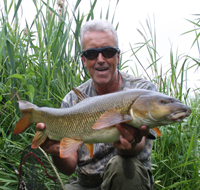 Because I like to use long hook links I then nick the hook into this bag so the bait isn’t dangling three feet below the PVA bag. This makes it so much easier for you to swing out the bag accurately and also to ensure it hits the water as gently as possible. As the bag melts the hook bait is released and it rolls down the current naturally.
Because I like to use long hook links I then nick the hook into this bag so the bait isn’t dangling three feet below the PVA bag. This makes it so much easier for you to swing out the bag accurately and also to ensure it hits the water as gently as possible. As the bag melts the hook bait is released and it rolls down the current naturally.
When doing this I avoid using a back lead whenever possible because having two leads on the line creates a bolero effect and it’s damn near impossible to get everything to land accurately and in a straight line. Furthermore the back lead itself becomes a deterrent as it will create the very ‘plop’ you’re aiming to avoid by employing a bag.
Which brings us back to the initial problem – floating weed and debris. To beat this I actually sink the rod tip until it is resting on the riverbed ensuring my line is then stretched taught across it.
 Sometimes I will use a back rod rest only with a gripper head. This holds the end of the rod butt as the weight of the rod and reel pins the tip to the river bed. This enables me to shin up the tree and observe both the fish and my rig. It’s great fun to see a barbel approaching your hook bait, to watch as it sucks in the hook and then see it shaking its head violently to try and dislodge the hook.
Sometimes I will use a back rod rest only with a gripper head. This holds the end of the rod butt as the weight of the rod and reel pins the tip to the river bed. This enables me to shin up the tree and observe both the fish and my rig. It’s great fun to see a barbel approaching your hook bait, to watch as it sucks in the hook and then see it shaking its head violently to try and dislodge the hook.
In the split second it takes to realise it has made an error I can be down the tree and on the rod. Obviously I do this with a fairy slack clutch but barbel rarely bolt off unless there’s some idiot pulling like hell on the other end of the line.
Try it sometime. You might find it makes all the difference.
Click HERE to purchase Barbel Days And Ways DVDs
PAYMENT BY CHEQUE:
If you prefer to pay by cheque or other means you can email Kate Walker at Kali Productions and she will make the neccessary arrangements:

Good article that Bob and totally agree with the boring “Bertie the Gertie” out.Not for me thanks all the same 😉